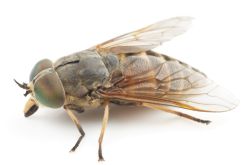Horse Fly
 Description:
Description:
Horse flies and deer flies are bloodsucking insects that can be serious pests of cattle, horses, and humans. Horse flies are a particular pest to livestock. Relentless biting attacks by females can result in reduced weight gain in some animals. Attack by a few of these persistent flies can make outdoor work and recreation miserable. Horse fly bites can be very painful for humans too .They have mouth parts that work like miniature knives, which they use to slash open the skin with a scissor–like motion. Flies and the intensity of their attack vary from year to year. Male horse flies are mainly pollen and nectar feeders and are most active during daylight hours.
Appearance: Adults can be up to 25 mm long. They are black to dark brown in color with green or black eyes. The males have contiguous eyes, which easily differentiates them from females where the eyes are widely separated.
Lifecycle: Mating is initiated in the air and completed on the ground where the female then deposits an egg mass sometimes with a shiny or chalky secretion, which aids in water protection. Eggs are laid in masses ranging from 100 to 1000 eggs on a vertical surface overhanging water or wet ground favorable to larvae development. The eggs hatch in 5–7 days. They overwinter in the larval stage and pupate during the spring and early summer. Adult life cycle is 30 to 60 days.
Habits: Horse fly females are aggressive blood feeders, while males do not consume blood but feed on pollen and plant nectars. Female horse flies usually bite large, nonmoving mammals on the legs or body. Deer flies, in contrast, attack moving hosts and typically target high on the body, like the head or neck. They rarely bite near the head. Horse flies have a range of hosts that include mammals of almost all sizes, livestock, humans, pets and birds. Should a female horse fly be interrupted when attempting to feed, they will fly off but quickly return to bite again, or go to another host to consume a complete blood meal. Horse fly larvae studied by field researchers feed on midges, crane flies and even other horse fly larvae. Because of their cannibalistic behaviors, horse fly larvae are usually found living alone. Deer fly larvae, on the other hand, usually live in groups. Pupae do not feed.